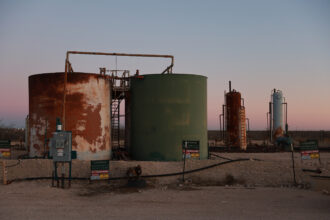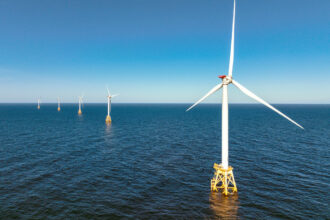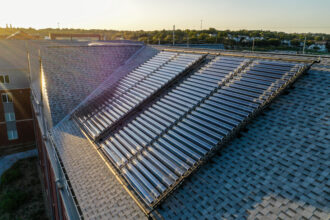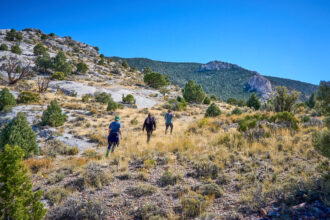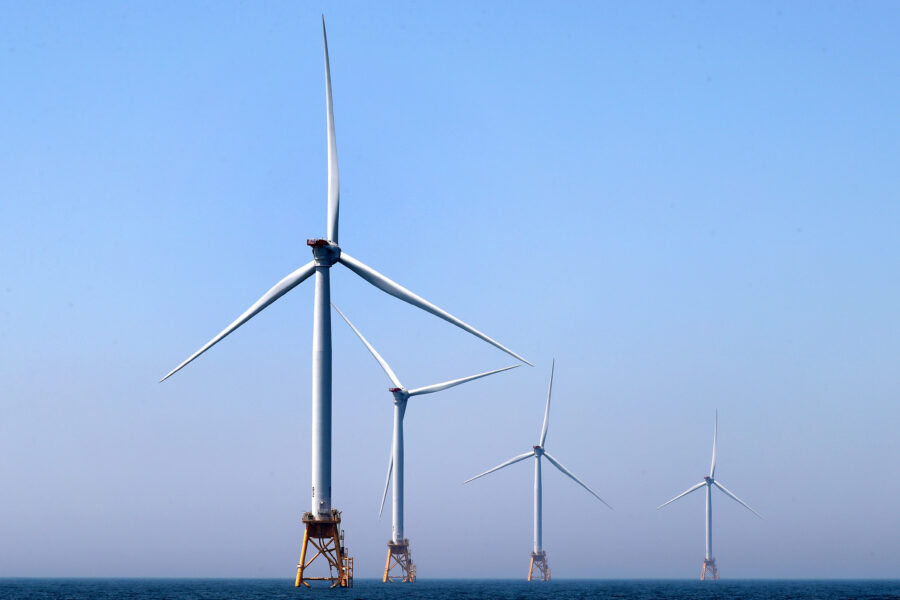ELY, Nevada—The smell of piñon pine filled the air as the Ghost Train of Old Ely rolled to a stop between the Duck Creek Range and another railway. Two peaks of jagged limestone towered above the sagebrush and juniper trees that filled the range, providing habitat for elk, deer, pronghorn, rattlesnakes and sage grouse. Sundown here in the Great Basin Desert reveals some of the darkest skies in the country.
Mark Bassett says for more than 20 years his full-time job has been “to put butts in seats” to see this stretch of the desert. He’s the executive director of the Nevada Northern Railway Museum, a national historic landmark, where workers dress in denim overalls and engineer caps to repair old steam engines, conduct them on the historic tracks and preserve railway records dating to the early 1900s.
“It’s been said that it’s like the workers went to lunch and just never came back,” he said of the museum, which seems to have stopped in time since the railway closed in 1983.
On most days, the train is filled with tourists, but on a sunny October afternoon, it was filled with a small group of locals and environmentalists to see how the area between the HiLine and Mainline railways in central Nevada could be filled with a million cubic yards of rubble during a seven-year industrial operation that would excavate a nearby mountaintop and further deplete the underground water supply.



All of it would be for a 1,000-megawatt, closed-loop pumped storage project—a nearly century-old technology undergoing a resurgence as part of the nation’s clean energy transition. Across the country, the hydropower industry, energy experts and lawmakers alike are proposing such projects that can store energy from wind and solar installations to provide electricity when the sun isn’t shining or the wind isn’t blowing.
“What makes pumped storage so unique and valuable in the energy transition is its ability to provide additional power when it’s needed most,” said Malcolm Woolf, president and CEO of the National Hydropower Association.
Pumped storage requires two water reservoirs, one above the other. At night, water is pumped uphill to the higher reservoir, then sent back down through electricity-generating turbines when energy demand peaks or renewable resources can’t generate electricity, helping to ensure grid stability during system-stressing events like record-hot summers. Pumped storage projects, however, can’t just be built anywhere. They need a mountainous area with a steep descent to give the water a strong enough flow to spin the turbines. So the majority of the nearly 100 pumped storage projects currently in the preliminary phase with the Federal Energy Regulatory Commission are throughout the mountainous Western U.S.

R Plus Hydro thought White Pine County in Nevada was an ideal location for one such project, with access to nearby transmission lines, federal lands to build on and water to draw from.
However, the project, one of the furthest along in the FERC permitting approval process approval process, is hitting roadblocks with locals ranging from Ely city leaders to ranchers, tribes and environmentalists.
The opposition cites a lack of communication from the developers, a plan to build on environmentally and culturally sensitive land, concern over what would become essentially a mining operation in the nearby mountains and a threat to the profitability of one the region’s biggest economic drivers—the Nevada Northern Railway Company, which attracts thousands of tourists year-round to what locals say is the most isolated town in the Lower 48.
Then there’s the water.
Closed loop pumped storage projects need water to work, usually by pumping aquifers or by bringing in surface water from a nearby river or lake (pumped storage can be built along a river, called open-loop, but such projects have received less support because they require dams, which have drawn fierce pushback in recent years).
Here in the drought-stricken Southwest, groundwater is in short supply.
“Among the most egregious things about a company like R Plus is that it masquerades as an environmental Moses,” said Kyle Roerink, the executive director of the Great Basin Water Network, an organization focused on water issues in Nevada and Utah, referencing the Biblical figure leading the Israelites to the promised land. “But in reality, they’re going to be pumping from a groundwater basin over-allocated on paper and teetering on the brink of not being able to provide for future generations.”
Supporters of the project, however, argue that pumped storage is the cheapest and most reliable way to provide the electricity storage needed for the clean energy transition and will help stimulate a rural community’s economy.
The project is far from being a done deal, said Matthew Shapiro, the company’s CEO. R Plus is looking to be a good neighbor, he said, while providing the storage capacity needed to make renewable energy reliable. “It’ll be all a win-win opportunity for the community,” he said. “They’ll have every economic driver that currently exists plus a project that would, by our estimations, perhaps double county tax revenue, so there’s a lot of benefits to go around. So it’s just a matter of continuing to be responsive and address concerns.”
The dispute adds yet another complication to the challenge of transitioning the nation’s grid away from oil, gas and coal.
“Storage is a real bottleneck for getting clean electrons into the grid,” said Daniel Inman, a senior scientist with the National Renewable Energy Lab who studies the lifecycles of energy systems. He led a recent study that found, throughout their lifespans, closed-loop pumped storage is the most environmentally friendly of the various energy storage technologies currently on the market, though water usage wasn’t considered in that research. It’s a proven technology, he said, making it easier to design, install and finance. It also helps create the inertia needed to keep up with electricity needs during peak demand and, once built, can last for nearly a century with routine maintenance. All of that has led to reservoirs providing around 90 percent of the country’s current energy storage capacity, and a resurgence of pumped storage development.
Other methods of storing electricity, like lithium-ion batteries, require mining, another issue hotly debated in the Silver State. Although pumped storage doesn’t need to mine for critical minerals, it can require an equivalent amount of digging, as with the operation near Ely, to build reservoirs and spillways.
But like all things in the West, it’s the water that will decide the Ely project’s fate—helping serve as a litmus test for what closed-loop pump storage projects must face as more are proposed in the region.

The main local aquifer that supplies nearby towns and would be used for the project in White Pine County is already over-appropriated by 75,955.79 acre feet—enough water for nearly 200,000 homes. The basin only yields about 70,000-acre feet a year, according to documents from a local water district, which has expressed serious concern over how the project could impact other users.
“Despite these clear effects, the District was unaware of the proposed project and projected groundwater pumping until days before the deadline to comment” on the project, the district, which doesn’t have jurisdiction over the water and isn’t required to be notified, wrote in a letter to FERC.
A Fight Over Water
Fighting over water is nothing new in White Pine County.
For decades, the county, local towns, tribes and environmentalists fought the Southern Nevada Water Authority over a plan to build a pipeline to pump the region’s groundwater for municipal use 300 miles away in the Las Vegas metropolitan area. The SNWA’s plan to pump 800,000 acre feet of water a year from the region finally failed in 2020.
However, the pumped storage project proposal has led alliances to shift. White Pine County has agreed to lease 8,688 acre feet of water to the project’s developers each year for six years for $50,000, with more being charged depending on how much is actually pumped, but the state only permitted 5,100 acre feet for the project. The allocation came from a water right given by the state water engineer to the county in 1978 for a coal fire plant that never materialized. Once built, the two reservoirs will need an additional 360 to 560 acre-feet a year to account for evaporative loss.
Community leaders in Ely say they were left out of the conversation and most only learned of the project after the water was already allocated. To many, it’s yet another water grab by big cities, this time to provide them with green electricity, that leaves rural communities with nothing for themselves and their future.
“The county turned around and just basically gave away the water to the cities in a different way,” said Rick Spilsbury, a member of the Ely Shoshone Tribe who serves on the board of directors for the Great Basin Water Network, which made its name fighting the SNWA’s plan. “It’s a pipeline without the pipeline.”

Despite the agreement between the county and R Plus Hydro, a subsidiary of a Salt Lake City-based real estate developer, no study has been conducted on the potential impacts on water in the region, even when the company submitted its final licensing application to the Federal Energy Regulatory Commission.
“They haven’t done their basic homework,” said Bassett, of the Nevada Northern Railway Museum, which has expressed numerous concerns over how the project can potentially impact the railway and the tourism it attracts. “I don’t know, it’s a water project. Call me crazy. Call me a little insane. That’d be the first study I’d do—make sure I got the water.”
Shapiro, the CEO of R Plus Hydro, said the water study is just one “of about 1,000 different studies, and we can’t do them all at once.”
However, a lack of details like that and a lack of consultation between various stakeholders resulted in FERC sending the company a list of 103 deficiencies in response to its final licensing application, which the company is currently working to resolve.
To even begin pumping the water, the state water engineer’s permit for the project requires that it submit a comprehensive monitoring plan, which has yet to be done. The state also granted the project less water than R Plus Hydro and the county initially asked for.
If the water doesn’t end up being used, the county will lose the right to it, according to the state’s permit. That’s because the county’s right to the water—which is part of 25,000 acre feet of water it has earmarked for industrial purposes since 1978—has never been put to beneficial use.
That’s forced the county to search for a way to use the water, Roerink said, because if they can’t use it, they’ll lose it. “This project exemplifies how regulatory constructs push communities into projects that are not in their best interest,” he said.
Railway Vital for Region’s Economy
If it wasn’t for the Nevada Northern Railway Museum, the city of Ely might have disappeared. When mines in the state began to shut down in the 20th century, the towns that served them quickly vanished, too. Today, Nevada is home to more ghost towns than any other U.S. state.
That could have happened to Ely, Bassett said, but the town came up with an offer to Kennecott Mining, which built and owned the railroad after copper was discovered in the nearby mountains: Give the city the railroad when the mine ceased operations so that Ely could develop a tourist attraction keep its economy afloat.
Kennecott said yes.
So 35 years later, the train depot remains open. Pristine buildings from the early 1900s dot the 56 acres that more than 100 historic rail cars and three restored steam locomotives call home.
Since it began operations 35 years ago, the museum helped draw thousands of visitors to the town of 2,000 and has brought in an estimated $107 million to White Pine County’s restaurants and hotels. Millions have been spent to preserve the railways and its locomotives, and recent grants for millions more will fund further restoration.



But visiting Ely is no easy task. The nearest major cities are Las Vegas and Salt Lake City. “Visitors coming to Ely, they’re committing to a 500-mile round trip at minimum,” Bassett said.
His concern—and that of many in the community—is that the pumped storage project will take the surrounding pristine landscape that draws many of the railway’s riders and turn it into an industrial site as the reservoirs needed for the project are built.
A pit eight stories deep would have to be dug into the nearby mountain range for the upper reservoir. It’ll be no easy task, said Roger Bowers, a licensed geologist from Ely who has consulted on mining operations in the region. Every time he sees new documents from the project, something changes, he said. When asked his thoughts on the excavation, he had one comment: “I wish them a lot of luck.”
Bassett expects a 20 to 30 percent drop in ridership if the project the train passes through is approved. That resulting drop in revenue would likely lead to layoffs in the museum’s full-time staff of 25, which could ripple through the city’s economy.
Ely Mayor Nathan Robertson isn’t completely opposed to the idea of the project. But he doubts it will be viable. And he thinks R Plus has botched its public relations. The company came in promising to save the town. But speculative development is nothing new here—Nevada did make its name on mining, he said.
“Over and over again for hundreds of years, this community has heard that,” he said. “We’re probably more skilled at this game than they are. And so when you come in, kind of with an inflated picture view of what you want to do, I think this community sees through that pretty quickly.”
‘Unspoiled Nevada’
The Western Shoshone called this stretch of the Great Basin Desert home for 20,000 years—since long before any railroad track was laid down.
On the other side of the mountain where the pumped storage project is proposed is the site of Bahsahwahbee, or Sacred Water Valley, a ceremonial and pilgrimage site where thousands gathered each year for generations. But during the 19th century, as the U.S. colonized the West, eleven massacres were carried out in the area, including three of the largest slaughters of Indigenous people on record.
At the site of Bahsahwahbee, swamp cedars grow out at elevations far below where they typically are found. “We believe our ancestors’ spirits are in the trees that grow in this valley,” said Delaine Spilsbury, an Ely Shoshone elder and the mother of Rick Spilsbury. The Duckwater Shoshone Tribe, the Ely Shoshone Tribe and the Confederated Tribes of the Goshute are now pushing for Congress to designate the area as the Bahsahwahbee National Monument. At the proposed site of the White Pine Pumped Storage project, on the other side of the nearby mountain ranges, dozens of Indigenous artifacts have been discovered.

Spilsbury’s main concern is the destruction of the local environment. Springs flow near her home in the Duck Creek Range. That water has been the lifeblood of her people for generations, and allowed plants and animals to thrive. For Spilsbury, bow hunting is a way of life; in her home, trophy animals cover the walls. Few places, she and others said, are better for hunting.
But over the years, game has grown less plentiful. Nearby lakes have been sucked nearly dry. “The hunting has gone way down and with this water project and destroying that mountain [for it], it’ll be absolute zilch,” she said.
The area is incredibly biodiverse, said Patrick Donnelly, the Center for Biological Diversity’s Great Basin director, and home to sage grouse lek habitat, where the threatened birds engage in their famed and elaborate mating rituals. “Once you destroy leks, the sage grouse stop mating and they die off,” he said. Sage grouse, he said, will literally stand at the edge of a development where a lek once was.
“It’s gorgeous. It’s unspoiled Nevada. It’s what makes Nevada great—one of those last best places,” Donnelly said. “So the idea that we’re going to put a hydro project and open up huge access roads for big rig trucks in all of this is just unconscionable.”
Dozens of applications to build new pumped storage projects throughout the Southwest have been filed with FERC since 2017, while more are likely on the way as solar and wind projects come online, tax credits under the Inflation Reduction Act incentivize the projects and legislation to reform permitting is pushed for in Congress to make it easier for closed-loop pumped storage developments and other energy projects to be built.
Hiking up the Duck Creek Basin where the upper reservoir of the White Pine Pumped Storage project is planned, Roerink repeated a common sentiment of environmentalists confronting clean energy projects being built on public lands: “Is this our next sacrifice zone?”
Dark Skies
Years ago, Mark Bassett stumbled upon a word he had never heard before—astrotourism.
About 60 miles east of Ely is Great Basin National Park. The park has been designated a “Dark Sky Place.” But getting to the park to see those dark skies is no easy task. “You drive out in the afternoon and they have a great astronomy program, but there’s no lodging there,” Bassett said. “So you’ve gone out, you observe the dark skies and now you have to drive 60 miles back on a two-lane highway across two mountain passes under guess what? Dark skies.”
So Bassett had an idea: Partner with the park to create a “star train” where passengers take one of the antique locomotives out at night with rangers on board.

The program has been wildly successful. Tickets go on sale a year in advance and sell out almost immediately. But the pumped storage project threatens that popular attraction. The site where the train stops for passengers to peer through telescopes is nearly in front of where the pumped storage project is planned to be built. If the project gets permitted, it will take at least seven years to build, and he expects there to be lights shining in the area nonstop.
At night outside of Rick and Delaine Spilsbury’s homes, those night skies that bring visitors to Ely from around the world are on full display. The stars are nearly overwhelming; there is no light besides that from the moon.
Outside the smell of piñon pine still lingers. Water gurgles in the nearby stream. Constellations rise everywhere and the clouds of the Milky Way smear the sky.
There are many things life does not offer here that you might find in a city, Rick said, but not views like these, which are becoming rarer by the year.









